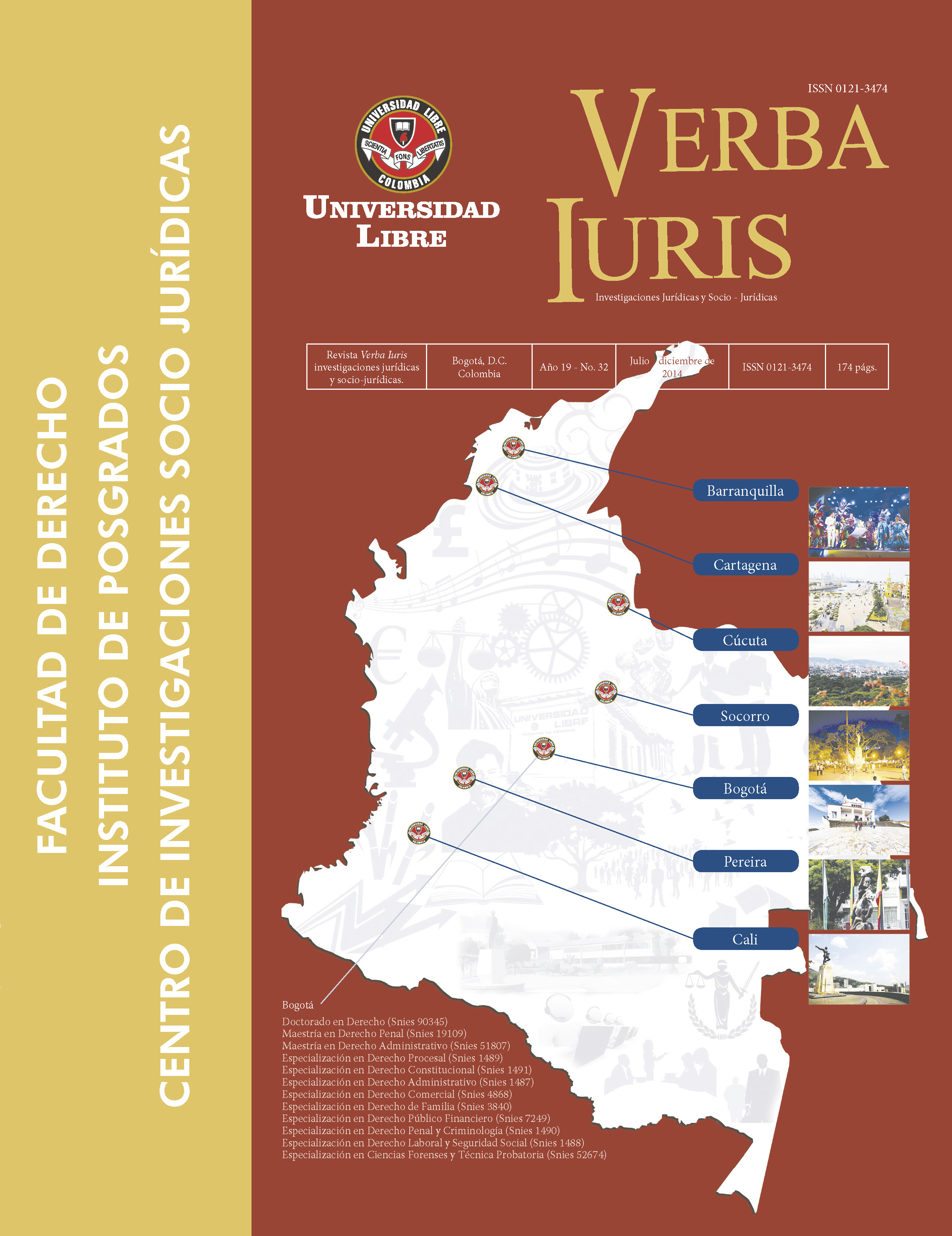Selectividad Penal y “Marco Jurídico para la paz” en Colombia
DOI:
https://doi.org/10.18041/0121-3474/verbaiuris.32.44Palavras-chave:
Tratamiento diferenciado, Priorización, Selección penal, Paz, Marco jurídicoResumo
El legislador a través de una reforma en la Constitución Política, ha autorizado la realización de procesos de selección penal (positiva y negativa), en relación con los grupos armados al margen de la Ley y los agentes del Estado que han cometido delitos en el marco del conflicto armado interno. Es la primera vez que se constitucionalizan en Colombia los procesos de selección penal y se autoriza la priorización de las investigaciones penales en relación con los máximos responsables de los delitos. Para comprender el alcance de la norma constitucional se realiza previamente un breve estudio de los que son los procesos de selección penal, para luego analizar el contenido de lo que se ha denominado el “Marco jurídico para la paz”, particularmente en lo que tiene que ver con el tratamiento diferenciado que conduce a la exclusión penal (renuncia condicionada de la acción penal) o a la atenuación de los delitos y las consecuencias jurídicas, lo que permite cierto grado de impunidad con tal de lograr una paz estable y duradera. La explicación se abordará desde el punto de vista criminológico.
Downloads
Referências
Baratta, Alessandro. (2004). Criminología crítica y crítica al Derecho penal. Introducción a la sociología jurídico-penal, Buenos Aires, Siglo XXI Editores.
Becker, Howard S. (1971). Los extraños. Sociología de la desviación, Buenos Aires, Editorial Tiempo Contemporáneo.
--------. (2010). Outsiders. Sociología de la desviación, Buenos Aires, Siglo XXI Editores.
Carranza, Elías. (1994). Criminalidad: ¿prevención o promoción?, San José, EUNED, Ed. Universidad Estatal a Distancia.
Comisión Colombiana de Juristas, Comentarios al Marco Jurídico para la paz, Bogotá, 4 de junio de 2012, http://www.coljuristas.org/ documentos/actuaciones_judiciales/comentarios_marco_juridico_2012-06-04.pdf.
Corte Constitucional, sentencia C-578 de 30 de julio de 2002, MP. Manuel José Cepeda Espinosa, http://www.corteconstitucional. gov.co/relatoria/2002/c-578-02.htm.
--------. Boletín de prensa Marco Jurídico para la paz, Bogotá, 28 de agosto de 2013, www.corteconstitucional.gov.co/inicio/BOLETÍN%20RUEDA%20DE% 20PRENSA%20MARCO%20JURIDICO%20 PARA%20LA%20PAZ.pdf, consulta realizada el 12 de noviembre de 2013.
Corte Interamericana de Derechos Humanos. “Sentencia en el caso Almonacid Arellano y otros versus Chile”, sentencia del 26 de diciembre de 2006, www.corteidh.org.cr González Monguí, Pablo Elías. (2013). Procesos de selección penal negativa, Bogotá, Universidad Libre.
Kitsuse, John I. (1962). “Societal Reaction to Deviant Behavior Problems of Teory and method”, Social Problems, vol. 9, published for: Te Society for the Study of Social Problems, University of California, Winter, pp. 247-256. www.jstor.org/stable/799235. Merton, Robert K. (2010). Teoría y estructura sociales, México, Fondo de Cultura Económica, 4ª edición.
República de Colombia. (1906). Código Penal, Ley 19 de 1890, Bogotá, Imprenta Nacional.
--------. (2012). Acto Legislativo No. 1 de 31 de julio de 2012, Bogotá, Congreso de la República, http://wsp.presidencia. gov.co/Normativa/actos-legislativos/Documents/2012/ACTO%20LEGISLATIVO%20 N%C2%B0%200 1%20DEL%2031%20DE%20 JULIO%20DE%202012.pdf. Consulta realizada el 12 de noviembre de 2013.
Sandoval Huertas, Emiro. (1985). Sistema penal y criminología crítica, Bogotá, Editorial Temis.
Schur, Edwin M. Our criminal society; the social and legal sources of crime in America, Englewood Cliffs, Prentice-Hall.
Silva García, Germán. (2011). Criminología. Teoría sociológica del delito, Bogotá, ILAE.
Tannenbaum, Frank. (1957). Crime and the community, New York, Columbia University Press.
Zaffaroni, Eugenio Raúl, Alagia, Alejandro y Slokar, Alejandro. (2002). Derecho penal, parte general, Buenos Aires, Ediar, 2ª edición.
--------. (2011). La palabra de los muertos. Conferencias de criminología cautelar, Buenos Aires, Ediar.


